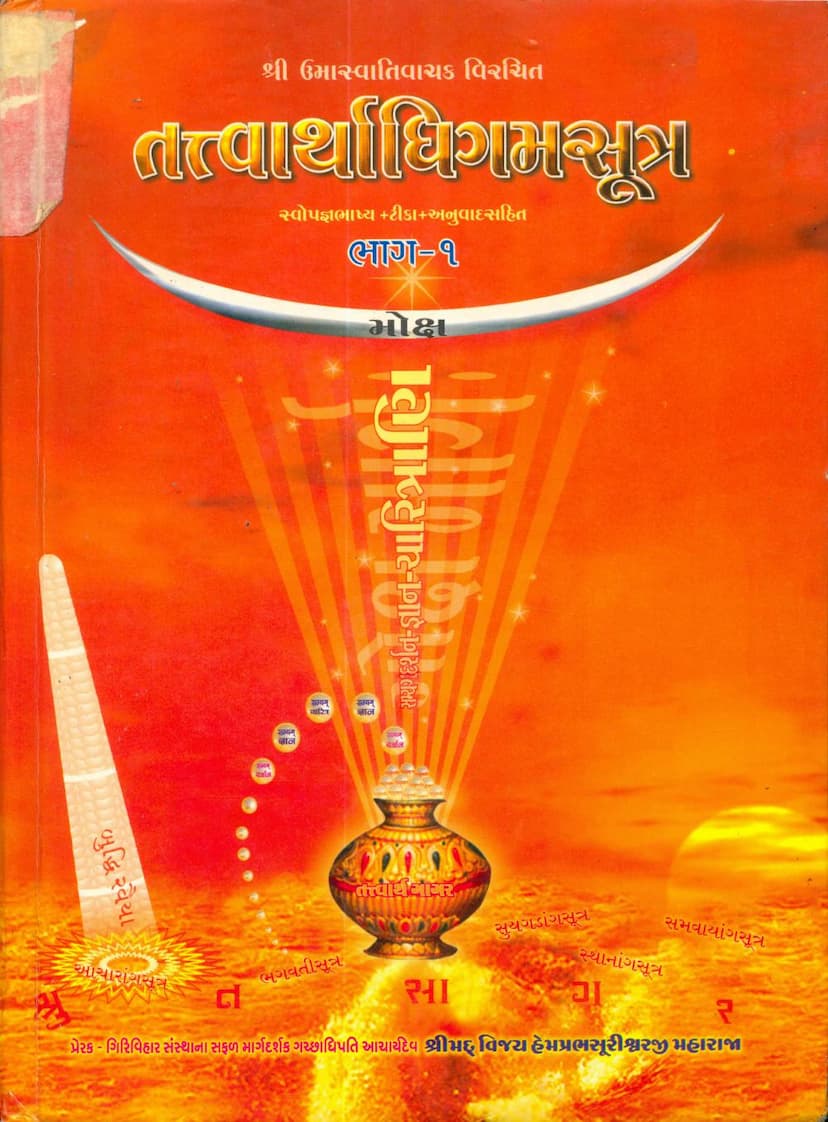Tattvarthadhigam Sutra Part 01
Added to library: September 2, 2025

Summary
Here's a comprehensive summary of the provided Jain text, "Tattvarthadhigam Sutra Part 01," based on the text you provided:
Book Title: Tattvarthadhigam Sutra Part Author: Udayprabhvijay (as the commentator/translator, with Umaswati as the original author of the Sutra) Publisher: Vijay Kesharchandrasuri Foundation Girivihar Turst Catalog Link: https://jainqq.org/explore/005749/1
Overall Nature of the Text:
This text is the first part of the Tattvarthadhigam Sutra, a foundational text in Jain philosophy, authored by Acharya Umaswati. This specific edition is presented with a Swopajnya Bhashya (original commentary by Umaswati) and a detailed commentary called "Hemgira" in Gujarati, along with a translation. The publication is by the Vijay Kesharchandrasuri Foundation Girivihar Trust and is dedicated to promoting Jain teachings. The text emphasizes the path to liberation (Moksha) as described in Jainism, focusing on the principles of Right Faith (Samyak Darshan), Right Knowledge (Samyak Gyan), and Right Conduct (Samyak Charitra).
Key Themes and Content Summarized from the provided pages (Pages 1-15):
-
Dedication and Reverence: The text begins with respectful salutations to various Tirthankar deities and revered Acharyas, highlighting the lineage of spiritual teachers and the importance of the Jain tradition. The first part of the book is dedicated to the author's spiritual teacher, Acharya Shri Hemprabhsurishwarji Maharaj, acknowledging his profound influence and guidance.
-
The Tattvarthadhigam Sutra's Significance:
- It is described as a comprehensive repository of Jain principles, a "garden of Jain doctrines" or an "orchard of Jain principles."
- It is considered universally acceptable across all Jain sects (Śvetāmbara, Digambara, Sthānakavāsī, and Terāpanthī).
- It is highly regarded, comparable to seminal texts in other philosophical schools like Vedanta's Brahma Sutras or Yoga's Yoga Sutras.
- Its accuracy is so profound that it is cited in the commentaries of prominent Śvetāmbara Acharyas like Acharya Malayagiri.
- The Sutra itself, though concise (around 198 verses), contains the essence of all Jain principles, making it a "ocean in a pot."
- It is believed that studying this Sutra with meaning yields immense spiritual merit, equivalent to 2000 gathas of study for the merit of one fasting day.
-
The Author and Commentary:
- The Tattvarthadhigam Sutra was authored by Acharya Umaswati, who is believed to have been a Dashapoorvdhar (one who possesses knowledge of ten Pūrvas).
- The commentary, Swopajnya Bhashya, is also by Umaswati.
- The Hemgira commentary and translation into Gujarati are by Muni Udayprabhvijay Gani, a disciple of Acharya Shri Vijay Hemprabhsurishwarji Maharaj.
- The Gandhahasti commentary by Shri Siddhasen Gani is highly praised and considered a significant elucidation of the Sutra and Bhashya.
-
Structure and Content of Part 1 (Chapter 1):
- The first chapter (Adhyaya 1) focuses on the path to liberation, particularly the nature of Right Faith (Samyak Darshan), Right Knowledge (Samyak Gyan), and Right Conduct (Samyak Charitra).
- It covers cosmology (world systems), the principles of dravya (substance), guna (attributes), and paryaya (modes), the nature of soul and non-soul, karma theory, the seven tattvas (realities), the twelve vows of householders, and the description of liberation.
- The text highlights the complexity and depth of Siddhasen Gani's commentary (Gandhahasti Tika), noting that while it unlocks the secrets of the Sutra and Bhashya, its profundity might make it challenging for some seekers. Hence, the Gujarati commentary Hemgira aims to simplify and clarify these profound concepts.
-
Scholarly and Editorial Efforts:
- The publication involved extensive research, consulting multiple ancient palm-leaf manuscripts to purify the original text and commentary.
- The editor, Muni Udayprabhvijay Gani, has put in immense effort to present a clear and accessible Gujarati interpretation, fulfilling a vital need for the spiritual community.
- The publication is supported by various Jain Sanghs and individuals, with a special mention of the inspiring presence and guidance of revered Acharyas of the Girivihar Sanstha.
-
The Author's Humility and Motivation:
- Acharya Umaswati is portrayed as immensely knowledgeable (author of 500 texts) yet remarkably humble, describing his work as searching for scattered grains in the vast city of Jain scripture.
- The author, Muni Udayprabhvijay, expresses profound gratitude and acknowledges the guidance and blessings of his Guru, Acharya Shri Vijay Hemprabhsurishwarji Maharaj, and other Vidyaguruvaryas, highlighting the collaborative and devotional nature of this scholarly endeavor.
In essence, the provided pages (1-15) serve as an introduction to the first chapter of the Tattvarthadhigam Sutra, emphasizing its timeless relevance, comprehensive scope, and the meticulous scholarly and devotional effort behind this particular publication. It sets the stage for a deep dive into Jain philosophy, guided by the profound commentary of Acharya Umaswati and the accessible Gujarati interpretation by Muni Udayprabhvijay.